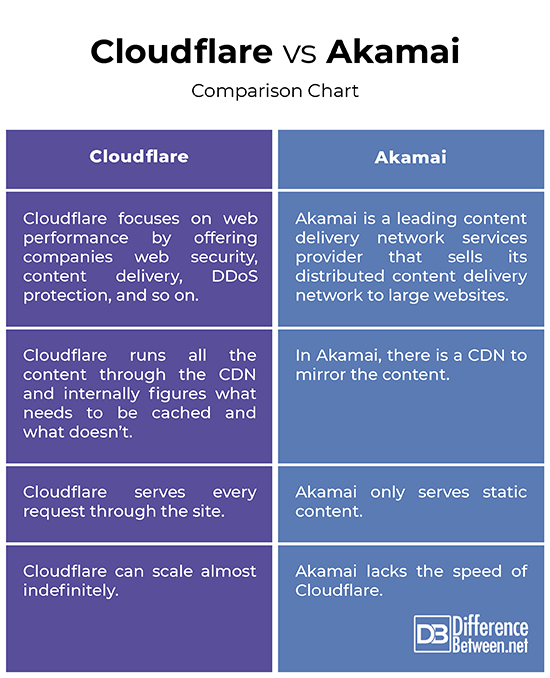Difference Between Cloudflare and Akamai
Today, almost all major websites and applications rely heavily on content delivery networks (CDNs) to better serve content to their consumers. There are good reasons why edge computing is moving into the forefront of the conversation in cloud computing. Initially designed to address the increasing demand for audio and video streaming and to fulfill growing volumes of content, CDNs now deliver more than half of the global internet traffic. Talking about CDNs, Cloudflare and Akamai are two of the world’s leading CDN service providers that provide web and internet security services. We pit the two content delivery networks against each other to understand which one’s better.

Cloudflare
Cloudflare is an American content delivery network provider that focuses on web performance by offering companies cyber security, DDoS protection, and services related to resilient DNS and content provision. Cloudflare provides a global network with unique performance capabilities. The idea is to build a better Internet by acting as an intermediary between a clients and a server, thereby enhancing the security and performance of everything connected to the internet. Cloudflare is a leader in providing cloud security and network services for global enterprises.

Akamai
Akamai is one of the world’s leading content delivery network services providers that works to making internet fast, secure and reliable. Akamai is a global web technology company founded in 1998 to provide a distributed computing platform for delivering and organizing online content and business applications. Headquartered in Cambridge, United States, Akamai Technologies today owns thousands of servers in more than 135 countries. Its Intelligent Edge Platform is one of the world’s largest distributed computing platforms. Akamai delivers static and dynamic content over HTTP and HTTPS.
Difference between Cloudflare and Akamai
Ease of Use
– One of the main differences between the two is that unlike Akamai, Cloudflare is not a traditional CDN. In a traditional CDN, there is a CDN to mirror the content. This approach requires the CDN to know where the content is updated, and then it is able to separate the dynamic content from the static content. This requires a lot of backend programming. Cloudflare, on the other hand, is a modern CDN that runs all the content through the CDN and internally figures what needs to be cached and what doesn’t.
Optimization
– While both the CDNs provide unique performance capabilities and unparalleled security, Cloudflare serves every request through the site while other CDNs including Akamai only serve static content. This allows Cloudflare to optimize much further. Because Cloudflare acts as a proxy between the applications server and the user, the analytics and apps are able to do this. After the server generates a response, Cloudflare alters it to include the new functionality you’ve added.
Cloudflare vs. Akamai: Comparison Chart

Summary
Although, Akamai has been around since before Cloudflare was founded in 2009, both are great companies with cutting edge technology and a lot of similar offerings. Choosing between the two is difficult because both are leading content delivery network services providers with a global reach. Both offer a whole range of CDN services and enterprise security and content delivery solutions. In terms of performance, Akamai cannot match of speed of Cloudflare and the latter can scale almost indefinitely. In addition, Cloudflare has a free plan for teams under 50, while Akamai does not offer any free plan.
FAQs
Who is Cloudflare’s biggest competitor?
There are many great alternatives to Cloudflare such as Akamai CDN, Fastly Deliver, CloudFront CDN, StackPath, Google Cloud CDN, and more.
What makes Cloudflare different?
What sets Cloudflare apart from other CDNs is that Cloudflare is not a traditional CDN. A more traditional CDN like Akamai would have a CDN to mirror your content. This would require the CDN to know where the content is updated, and separate the static content from the dynamic content.
What is the purpose of using Akamai?
Akamai is basically a cloud service provider that sells its distributed content delivery network to large websites. Akamai servers deliver static, dynamic content, and streaming audio and video.
Is Cloudflare just a CDN?
Cloudflare is a leading content delivery network provider with enterprise-grade security and reliability. It is not only a CDN but also offers companies cyber security, DDoS protection, and services related to resilient DNS and content provision.
What is Cloudflare used for?
Cloudflare is a leading CDN services provider that manages global distributed network of servers that work in tandem to provide fast content deliver over the internet.
Is Cloudflare owned by Google?
No. Cloudflare is not owned by Google. In fact, Cloudflare Inc. is an American CDN and DDoS mitigation company that focuses on web performance by making internet content faster to access.
Why is Cloudflare on my computer?
Many websites use Cloudflare to mitigate DDoS attacks and ensure the websites are running at all times without any downtime.
Is Cloudflare a VPN?
WARP by Cloudflare is a VPN that helps you connect to the Internet privately. The WARP client sits between your device and the internet.
What does Akamai do?
Akamai provides web and internet security services to large websites to make digital experiences fast and secure. It provides a distributed computing platform for delivering and organizing online content and business applications.
Does Microsoft use Akamai?
Akamai leverages Microsoft’s Azure Media Services to deliver live and on-demand streaming workflows
What are Akamai products?
Akamai providers a fine range of security and content delivery solutions including Edge DNS, Akamai Segmentation, Akamai Apps & API Protector, Bot Manager, Secure Internet Access Enterprise, Identity Cloud, Web Application Protector, and many more.
Is Akamai a firewall?
Akamai is a cloud based web application firewall (WAF) platform that protects your API deployment from DDoS attacks and mitigated all types of cyberattacks on web applications
- Difference Between Caucus and Primary - June 18, 2024
- Difference Between PPO and POS - May 30, 2024
- Difference Between RFID and NFC - May 28, 2024
Search DifferenceBetween.net :
Leave a Response
References :
[0]Sabella, Dario, et al. Multi-Access Edge Computing in Action. Florida, United States: CRC Press, 2019. Print
[1]Singh, Rajeev and Mangey Ram. Distributed Denial of Service Attacks: Concepts, Mathematical and Cryptographic Solutions. Berlin, Germany: Walter de Gruyter GmbH, 2021. Print
[2]Buyya, Rajkumar, et al. Content Delivery Networks. Berlin, Germany: Springer Science & Business Media, 2008. Print
